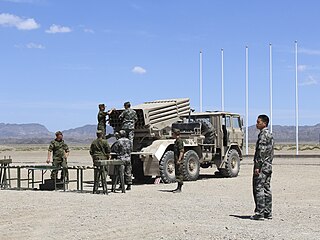This page is based on this
Wikipedia article Text is available under the
CC BY-SA 4.0 license; additional terms may apply.
Images, videos and audio are available under their respective licenses.

A multiple rocket launcher (MRL) or multiple launch rocket system (MLRS) is a type of rocket artillery system. Rockets have different capabilities than artillery, like longer range and different payloads, typically considerably larger warheads than a similarly sized artillery platform or multiple warheads.
Unguided rocket artillery is notoriously inaccurate and slow to reload compared to artillery. To overcome this rockets are combined in systems that can launch multiple rockets simultaneously.
Modern rockets can use GPS or inertial guidance to combine the advantages of rockets with high accuracy.

The BM-27 Uragan is a self-propelled multiple rocket launcher system designed in the Soviet Union. It began its service with the Soviet Army in the late 1970s, and was its first modern spin and fin stabilized heavy multiple rocket launcher.

The BM-21 "Grad" is a Soviet truck-mounted 122 mm multiple rocket launcher. The weapons system and the M-21OF rocket which it fires evolved in the early 1960s and saw their first combat use in March 1969 during the Sino-Soviet border conflict.
BM stands for boyevaya mashina, and the nickname grad means "hail". The complete system with the BM-21 launch vehicle and the M-21OF rocket is designated as the M-21 field-rocket system. The complete system is more commonly known as a Grad multiple rocket launcher system. In NATO countries the system was initially known as M1964. Several other countries have copied the Grad or have developed similar systems.

The BM-14, is a Soviet-made 140mm multiple launch rocket system (MLRS), normally mounted on a truck.

The BM-30 Smerch, 9K58 Smerch or 9A52-2 Smerch-M is a Soviet heavy multiple rocket launcher. The system is intended to defeat personnel, armored, and soft targets in concentration areas, artillery batteries, command posts and ammunition depots. It was designed in the early 1980s and entered service in the Soviet Army in 1989. When first observed by the West in 1983, it received the code MRL 280mm M1983. It is being superseded by the 9A52-4 Tornado since 2018.

The Rocket Launcher T34 (Calliope) was a tank-mounted multiple rocket launcher used by the United States Army during World War II. The launcher was placed atop the M4 Sherman, with its prominent vertical side frames firmly anchored to the turret's sides, and fired a barrage of 4.5 in (114 mm) M8 rockets from 60 launch tubes. It was developed in 1943; small numbers were produced and were used by various US armor units in 1944–45. It adopts its name from the musical instrument "Calliope", also known as the steam organ, which had similar parallel or clustered pipes, and which had historically existed on steamboats of the Mississippi River in the United States, or as is more commonly known and associated with traditional "circus music".

The M-77 Oganj is a 128mm self-propelled multiple rocket launcher developed in the former Yugoslavia. NATO designation is the YMRL-32

The M-63 Plamen is a 128mm multiple rocket launcher developed in 1963 in Yugoslavia for use in the Yugoslav People's Army.

The SNEB rocket is an unguided air-to-ground 68 mm (2.7 in) rocket projectile (RP) manufactured by the French company TDA Armements, designed for launch by combat aircraft and helicopters. Two other rockets were developed in the 37 mm (1.5 in) and 100 mm (3.9 in) caliber. The 37mm caliber was one of the earliest folding fin free flight rockets developed after World War II and was developed mainly for air-to-air engagements and is no longer in service. The 100mm caliber is in service with the French Air Force and a few other air forces. The 68mm caliber is by far the most popular in use today in both the time span of service and numbers produced, even out pacing the Russian 57mm air-to-ground rocket. This armament is commonly referred to in both military and civilian publications as the "SNEB rocket pod". Besides France, several other nations produce the SNEB 68mm rocket under license. In France today, SNEB has been reorganized into the firm of Thomas-Brandt.

The WM-80 was a multiple rocket launcher used by the People's Liberation Army of China and sold to other states like Armenia.
The Type 83/WM-80 was a 4 tube multiple rocket launcher used by the People's Liberation Army of China.

The Type 75 130 mm Multiple Rocket Launcher was developed to carry the 130 mm rocket system developed by the Aerospace Division of the Nissan Motor Company. It used the suspension, tracks and diesel engine of the Type 73 Armored Personnel Carrier. Komatsu was responsible for the chassis and IHI Aerospace, as Nissan's Aerospace Division has since been renamed, for the launcher and its rockets. 15 Type 75 wind measurement vehicles were built on the same chassis to provide weather information for the rockets.

The Type 63 multiple rocket launcher is a towed, 12-tube, 107mm rocket launcher produced by the People's Republic of China in the early 1960s and later exported and manufactured globally. Although no longer serving with active infantry units, the Type 63 is still in People's Liberation Army service with specialized formations such as mountain infantry units and special forces detachments. The Type 63 was widely used in the PLA until the late 1980s. It was adopted as the successor of the Type 50-5 of 102mm.

The Naze'at 6-H and Naze'at 10-H are two Iranian long-range artillery rockets with ranges of about 100 km. The Naze'at 10-H is larger, more powerful, and has a longer range than the Nazeat 6-H. Like Iran's similar shaped Zelzal rockets, Naze'at rockets do not have a guidance system. Both systems are also widely known without the -H suffix, as the Naze'at 6 and Naze'at 10.

The Type 81 is a self-propelled 122 mm multiple rocket launcher (SPMRL) produced by the People's Republic of China for the People's Liberation Army Ground Force. It is a variant of the Soviet BM-21 Grad. The Type 81 was the first in a family of Chinese self-propelled 122 mm rocket launchers.

The LRSVM Morava is a multiple rocket launcher system developed in Serbia. Designed as a modular, lightweight and universal version of the M-63 Plamen, M-77 Oganj and BM-21 Grad MLRS. It was first unveiled in 2011 as a more tactically and universal mobile version. It is developed by Military Technical Institute Belgrade (VTI) who has longtime experience in developing MLRS systems including most powerful at time of development 262mm M-87 Orkan. After successful transfer of technology and collaboration with UAE Emirates Defense Technologies in developing their MLRS based on Nimr platforms VTI has completed new universal modular MLRS dubbed Morava. This model is aimed at replacing the current generation of Russian MLRS, including BM-21 Grad, and Serbian MLRS M-77 Oganj and M-63 Plamen in all version. There is a version designated for export.















